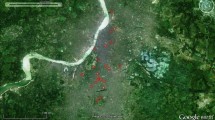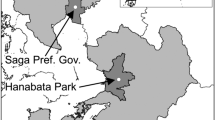Summary
Why does MagpiesPica pica roost communally rather than solitarily in winter? Most roosts were situated in deciduous trees near water, and they held relatively small numbers of birds. All Magpies roosted communally in winter. Strong winds reduced the height of roost perches, and roosting in leeward conditions increased. Less time was spent at the roost before and following roosting in winter when compared with the autumn and the spring situations. Magpies from high quality territories arrived late in the evening and left early in the morning. Foraging activity increased at the roost as day-length decreased, whereas flying remained constant. Sexual and aggressive behaviour were common in spring. Juveniles were sub-ordinate at the roost. Communal gathering was common at the roost. Several activities occurred frequently either at the pre-roost or at the roost, but aggressive and sexual behaviour had a spatial distribution as expected from the number of birdhours spent in the two sites. Roosting ceased following initiation of nesting activity, but early nesters attended the roost longer than late nesters following start of nest building. Start of breeding was not synchronized within roosts. Predation was rare at the roost and elsewhere in the study area. Roosting seems not to be due to information centre effects, predator avoidance, favourable micro-climate, lack of roost sites, or synchronization of breeding activities. Magpies may monitor the quality of their neighbours including their mating status at the roost. Communal roosting of corvid species seems to be related primarily to the distribution and the abundance of food, species with an unpredictable food supply roosting communally.
Zusammenfassung
Warum ziehen Elstern Gemeinschaftsschlafplätze der Einzelübernachtung vor? Viele Übernachtungsplätze liegen in Laubbäumen am Wasser und werden meist nur von relativ wenigen Individuen benutzt. Im Winter übernachteten jedoch alle Elstern in größeren Scharen (Abb. 1). Starker Wind verringert die Höhe der Sitzplätze und begünstigt leewärts gelegene. Vor und nach dem Übernachten waren die Elstern im Winter weniger lange Zeit answesend als im Frühjahr und Herbst (Abb. 6). Elstern aus Revieren hoher Qualität kamen abends später und flogen morgens früher wieder ab (Abb. 7, 8). Nahrungssuche am Übernachtungsplatz nahm mit abnehmender Tageslänge zu; Flugaktivität blieb konstant. Im Frühjahr waren Anzeichen von Aggressivität und Sexualverhalten häufig. Juv. nahmen an Übernachtungsplätzen niedrigere Rangstellungen ein. Schwarmbildung war häufig. Verschiedene Aktivitäten waren häufig entweder vor oder am Übernachtungsplatz festzustellen, doch Aggressiv- und Sexualverhalten konzentrieren sich meistens auf Plätze außerhalb. Nach Beginn des Nestbaus wurde der gemeinsame Übernachtungsplatz nicht mehr aufgesucht (Abb. 12), doch blieben Frühbrüter relativ länger als Spätbrüter gemessen am Stand des Brutgeschäfts. Innerhalb einer Übernachtungsgesellschaft verlief der Beginn des Nestbaus nicht synchron. Der Feinddruck am Schlafplatz wie im übrigen Untersuchungsgebiet war sehr gering. Gemeinsames Übernachten scheint keine Bedeutung als Informationszentrum oder für Verringerung der Feindeinwirkung zu besitzen, noch ist es wegen günstigen Mikroklimas, des Fehlens geeigneter Übernachtungsplätze oder als Mittel der Synchronisation des Brutgeschäftes erklärbar. Elstern prüfen vielleicht die Qalität ihrer Nachbarn und ob sie verpaart sind. Gemeinsames Übernachten scheint bei Corviden in erster Linie mit der Verteilung und Menge der Nahrung zusammenzuhängen: Arten mit einem nicht vorhersagbaren Nahrungsangebot übernachten gemeinsam.
Similar content being viewed by others
Literature
Baeyens, G. (1979): Description of the social behaviour of the Magpie (Pica pica). Ardea 67: 28–41.
Baeyens, G. (1981): Functional aspects of serial monogamy: the Magpie pair-bond in relation to its territorial system. Ardea 69: 145–166.
Bayer, R. D. (1983): How important are bird colonies as information centers? Auk 99: 31–40.
Brennecke, H.-E. (1965): Notizen an einem schleswig-holsteinischen Elsternschlafplatz. Corax 1: 82–87.
Bährmann, U. (1952): Ein Beitrag zur Biologie der Elster (Pica pica pica (L.)). Bonn. zool. Beitr. 3: 289–304.
Francis, W. J. (1976): Micrometeorology of a Blackbird roost. J. Wildl. Mgmt. 40: 132–136.
Gadgil, M. (1972): The function of communal roosts: relevance of mixed roosts. Ibis 114: 531–533.
Goodwin, D. (1976): Crows of the world. Ithaca: Comstock.
Gyllin, R., &H. Källander (1977): Nattlig samvaro. Fauna och Flora 72: 18–24.
Ditto &M. Sylvén (1977): The microclimate explanation of town centre roosts of JackdawsCorvus monedula. Ibis 119: 358–361.
Högstedt, G. (1980): Evolution of clutch size in birds: adaptive variation in relation to territory quality. Science 210: 1148–1150.
Jones, R. E. (1960): Activities of the Magpie during the breeding period in southern Idaho. Northw. Sci. 34: 18–24.
Kelty, M. P., &S. I. Lustick (1977): Energetics of the starling (Sturnus vulgaris) in a pine wood. Ecology 58: 1181–1185.
King, J. R., &J. N. Mugaas (1981): Annual variation of daily energy expenditure by the Blackbilled Magpie: a study of thermal and behavioural energetics. Studies Avian Biol. 5: 1–78.
Lack, D. (1968): Ecological adaptations for breeding in birds. London: Chapman and Hall.
Loman, J., &S. Tamm (1980): Do roosts serve as “information centers” for crows and ravens? Am. Nat. 115: 285–289.
Møller, A. P. (1982): Characteristics of MagpiePica pica territories of varying duration. Orn. Scand. 13: 94–100.
Ditto (1983): Habitat selection and feeding activity in the MagpiePica pica. J. Orn. 124: 147–161.
Roed, U. (1971): Ravnesoveplads. Feltorn. 13: 123.
Schramm, A. (1974): Einige Untersuchungen über Nahrungsflüge überwinternder Corviden. J. Orn. 115: 445–453.
Stork, H. J., &B. Jänicke (1977): Radarbeobachtungen der Schlafplatzflüge in Berlin überwinternder Krähen. Orn. Ber. Berlin (West) 2: 151–174.
Swingland, I. R. (1977): The social and spatial organization of winter communal roosting in Rooks (Corvus frugilegus). J. Zool. 182: 509–528.
Tatner, P. (1982): The density of breeding MagpiesPica pica L. in an urban environment. Naturalist 107: 47–58.
Verbeek, N. A. M. (1973): The exploitation system of the Yellow-billed Magpie. Univ. Calif. Publ. Zool. 99: 1–58.
Walsberg, G. E., &J. R. King (1980): The thermo-regulatory significance of the winter roost-sites selected by robins in Eastern Washington. Wilson Bull. 92: 33–39.
Waltz, E. G. (1981): Resource characteristics and the evolution of information centers. Am. Nat. 119: 73–90.
Ward, P. (1965): Feeding ecology of the Black-faced DiochQuelea quelea in Nigeria. Ibis 107: 173–214.
Ward, P., &A. Zahavi (1973): The importance of certain assemblages of birds as “information-centres” for food-finding. Ibis 115: 517–534.
Weatherhead, P. J. (1983): Two principal strategies in avian communal roosts. Am. Nat. 121: 237–243.
Wynne-Edwards, V. C. (1962): Animal dispersion in relation to social behaviour. Edinburgh: Edinburgh University Press.
Yom-Tov, Y. (1979): The disadvantage of low positions in colonial roosts: an experiment to test the effect of droppings on plumage quality. Ibis 121: 331–333.
Ditto,Imber, A., &J. Ottermann (1977): The micro-climate of winter roosts of the StarlingSturnus vulgaris. Ibis 119: 366–368.
Zahavi, A. (1971): The function of pre-roost gatherings and communal roosts. Ibis 113: 106–109.
Zink, G. (1949): Beobachtungen am Elsternschlafplatz. Orn. Beob. 46: 101–106.
Author information
Authors and Affiliations
Rights and permissions
About this article
Cite this article
Møller, A.P. Communal roosting in the Magpie (Pica pica). J Ornithol 126, 405–419 (1985). https://doi.org/10.1007/BF01643405
Published:
Issue Date:
DOI: https://doi.org/10.1007/BF01643405




